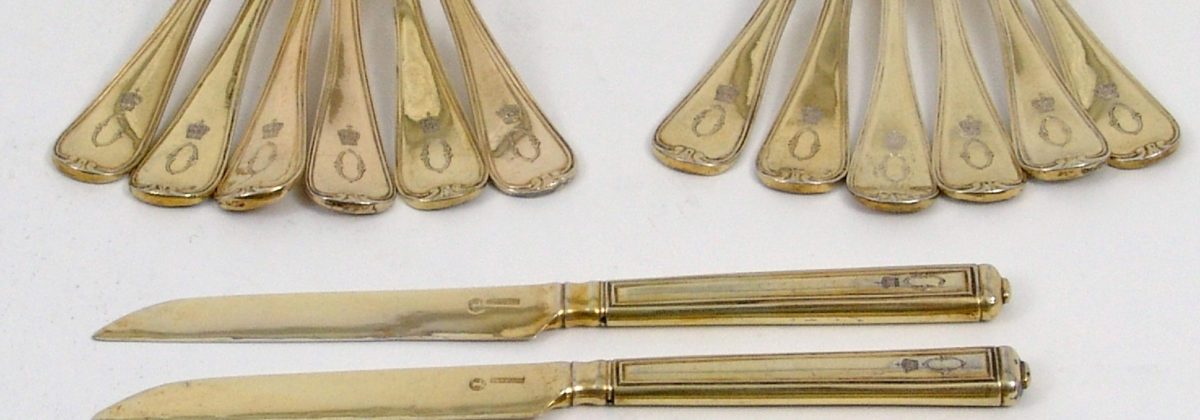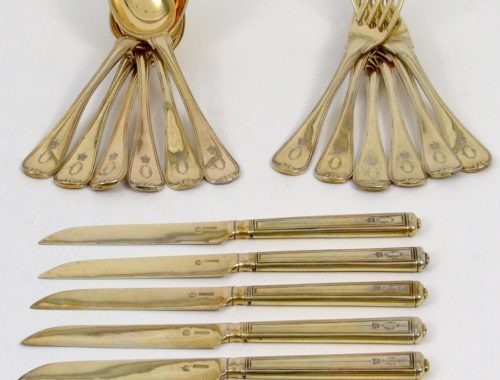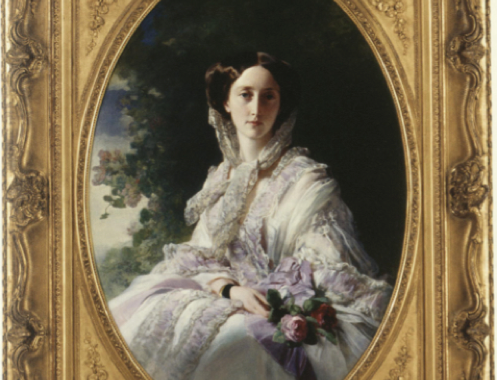Objektnummer: #356
Berlin 1817
Johann Georg Humbert
City’s hallmark: standing bear with an “I” in oval for early nineteenth century (1817-1819) (Rosenberg no. 1160; Scheffler no. 13)
Maker’s mark: “HUMBERT” in an elongated shield for Johann Georg Humbert (Rosenberg no. 1228; Scheffler no. 1388).
Engraving: crowned “O”, monogram of Olga, Queen consort of Württemberg (1822-1892).
Detailed Information
Eighteenth-Part Silver-Gilt Dessert Cutlery Set with the Monogram of Olga, Queen Consort of Württemberg
The set consists of six spoons, six four-pronged forks and six knives. The spoons have a deep oval bowl. Both spoons and forks have a stem lined with a continuous thread. A very beautiful decorative detail is the ending of the grip. The knife has a squared stem which ends in a knob. All knives, as well as spoons and forks are decorated with the crowned “O”. The marks are ligated on the backside of the stem and on the blade for the knives.
For the monogram of Olga, see a silver dish in the Landesmuseum Württemberg, Stuttgart.
Olga Nikolaevna of Russia (1822-1892), Queen consort of Württemberg
Olga was born in 1822 as the third child of the Grand Duke Nicholas I, Emperor of Russia and his wife, Alexandra Feodorovna (born Princess Charlotte of Prussia). She spent her childhood in Sankt Petersburg and she got engaged to Charles I of Württemberg – son of her uncle, king William I of Württemberg – in Palermo in 1846. They got married the same year and she became queen of Württemberg in 1864. Olga was above all active in the social sector. She has founded several establishments in Stuttgart, which still carry her name. The childless Olga and Charles adopted in 1870 her niece, Grand Duchess Vera Constantinovna of Russia, later duchess of Württemberg. Olga died in 1892 at her summer house in Friedrichshafen.
Olga and Charles have appreciated each other and went together on various trips. Their common interests for art, music, theatre and literature have helped them bring and keep up to the outward world the image of a harmonious married couple. However, their marriage was burdened by the childlessness and the homosexual relationships of Charles. Social engagement became thus the principal activity of Olga.
Queen Olga had a taste for historical rooms and opulent interiors. Besides that, she had already become a rich dowry, which contained also silver – just like her sister Alexandra Nikolaevna, who she had married to Prince Frederick William of Hesse-Kassel. This was packed in 307 boxes and was transported to Stuttgart over the Baltic Sea.
Olga was the owner of many splendid objects made of silver, as an auction catalogue of the house Albert Kende (in Vienna) from 1935 demonstrates. Besides that, the Landesmuseum Württemberg in Stuttgart owns – next to other objects related to her – a series of silver objects (e.g. dishes) from the Grenadier-Regiment “Königin Olga” no. 119, which belonged to the army of Württemberg and held Olga’s name from 1806 to 1919. Queen Olga is supposed to have laid the ground stone for the silverware of the regiment with her gift of cutleries. In addition to these, came gifts for the departure of officers, which had as a typical feature the crowned monogram “O” of Olga.
Maker
Johann Georg Humbert was the son of the silversmith Jeremie Humbert and was born in Berlin in 1770. From 1784 until 1790, he apprenticed by his father and became a warden in 1796. There were periods when Humbert had 108 employees in his workshop. He died in 1837.
Literature
Rijn, Maaike van/Landesmuseum Württemberg (hrsg.), Im Glanz der Zaren: Die Romanows, Württemberg und Europa, Ulm: Thorbecke/Landesmuseum Württemberg, 2013.
Scheffler, Wolfgang, Berliner Goldschmiede : Daten, Werke, Zeichen, Berlin : Hessling, 1968




